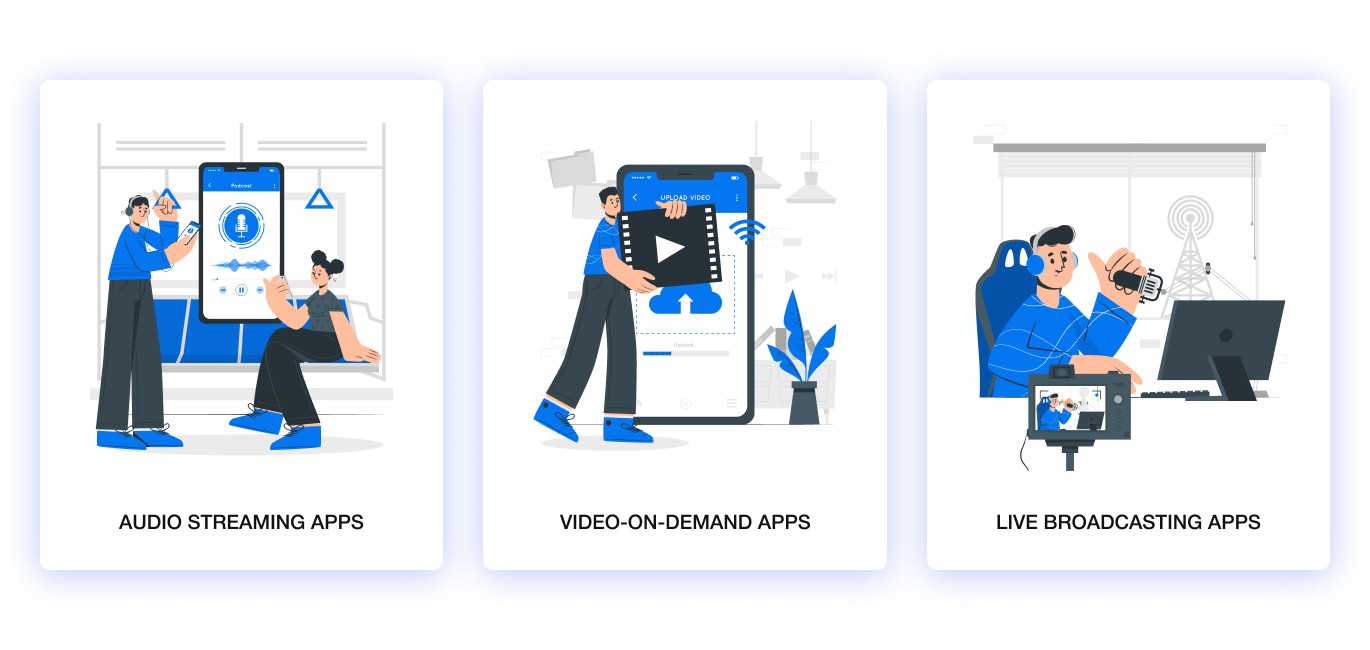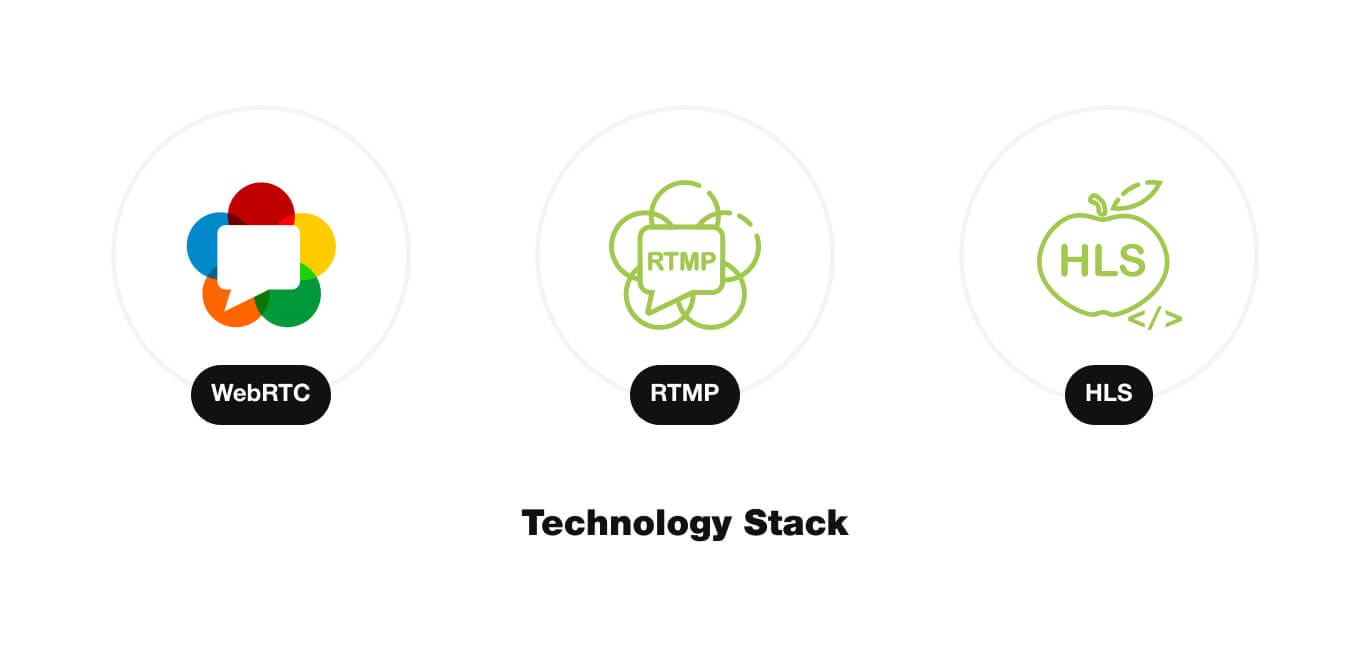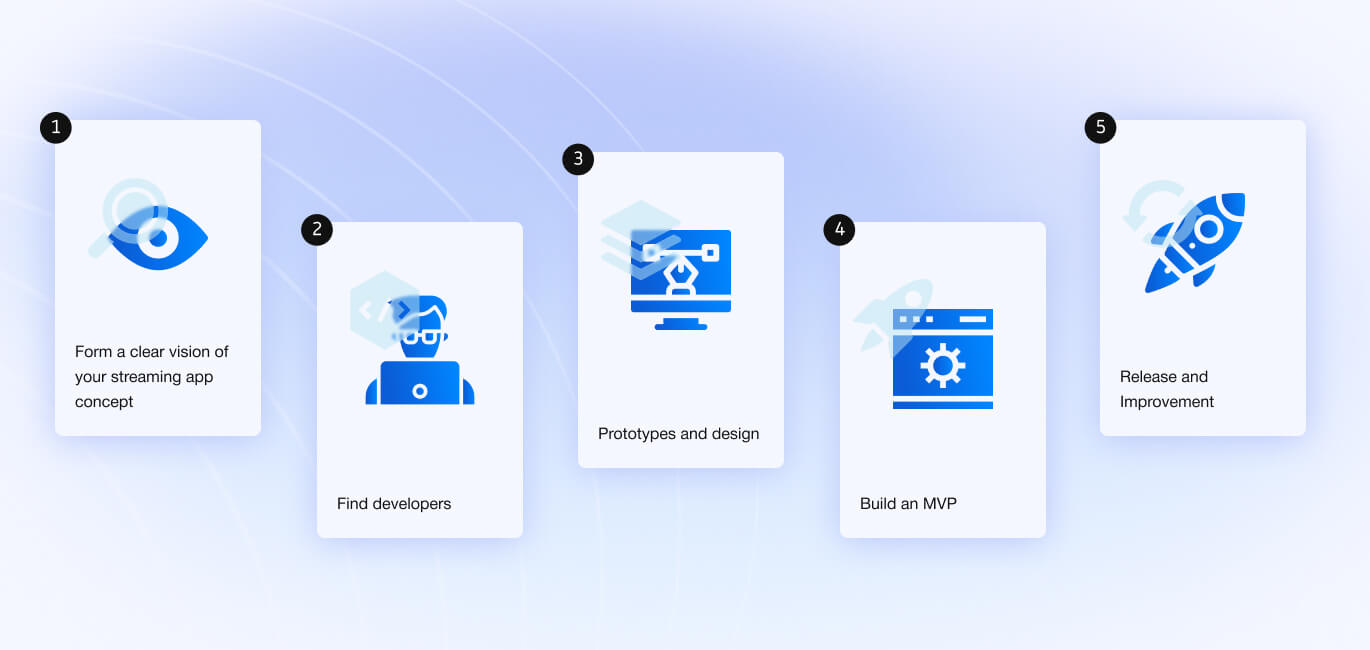How to Build a Live Video Streaming App: Tech Stack, Tips and Costs
 5 January 2022
5 January 2022Live streaming is prevalent in today’s media landscape. Content of this type is becoming more popular and capturing more viewers’ attention every year. Globally, the live-streaming market is expected to reach $223.98 billion by 2028, according to analysts. More and more businesses are creating their live-streaming applications, which explains why this industry is growing.
You need to know how your live-streaming application will appear and have a rough idea of how it will function. Such understanding will enable you to build a live-streaming app. This article aims to examine the development of live-streaming apps and the features they include, and proper development pipelines.
Live-Streaming Stats You Should Know
- The number of live-streaming users in China reached 617 million in 2020.
- According to US consumer research, live videos are preferred to blog posts by 80% of the population.
- Live-streaming has 27% more watch time per viewing, nearly six more minutes than on-demand video.
- Globally, 75% of consumers watched streaming content in 2020.
- Marketing videos are used by 86% of organizations to promote their product
Why Is Live Video-Streaming App Development a Challenge?
A live-streaming app allows users to record and broadcast video simultaneously. Thanks to high-speed internet and advanced camera technology, these apps have increased in number in recent years. These apps have facilitated influencer marketing, entertainment, business marketing, and online interaction. However, they come with some development challenges.
Thinking about how to make a live-streaming app? Here are a few things you should be prepared to tackle.
1. Technical challenges
While streaming technology has advanced immensely over the last two decades, it continues to face distinct challenges. The problem of bandwidth restrictions, latency difficulties, and device compatibility prevent viewers from enjoying smooth video streaming.
2. Complex app architecture
Most video streaming app development requires a high level of expertise due to the numerous features these systems often have. Without the input of top professionals, you might not be able to achieve this.
3. Scaling and Performance
A real-time streaming system should respond to simultaneous connections from different users. The system must adapt without lagging when multiple devices are connected. Usually, most streaming servers have a rigid number of viewers and streams they can run simultaneously. Exceeding this number overloads the server, and the developer or team cannot keep track of this large amount of data. Scaling becomes difficult, and performance drops.
4. Security
Access rights to data, systems, and terminal devices can be distributed and adjusted by users based on their roles. As such, you need to plan against cyber attacks by encrypting the data, both in motion and at rest, drafting a Copyrights policy, protecting passwords on your platform, allowing Geo-blocking, allowing IP access restriction, among others. Also, your platform should have an in-built content management system (CMS) and a real-time dashboard that helps track streams and prevent technical issues. Additionally, ensure your embedded code can only work on whitelisted domains.
Major Market Challenges
There are also a few market challenges that you might face when you decide to build a live-streaming app.
1. High market competition
One of the major challenges is the high level of market competition. With major players such as Twitch, YouTube Live and Periscope taking chunks of the audience, you will need to find the right marketing strategy to break into the market and sweep your own loyal audience.
2. Development cost is above average
The cost of development is high. More on the cost of live-streaming app development below.
3. Constant idea validation
Considering the level of flexibility of the market, you need to constantly review your ideas when major trends arise. You don’t want to be left behind.
Types of Live-Streaming Apps

You must determine the type of live-streaming app you want to build before you begin. Live-streaming apps can either be audio-only or audio and video.
Audio streaming apps
By taking video out of the picture, you’ve got an audio streaming app. Streaming audio allows you to listen to audio in real-time over the internet. Spotify, Pandora and Clubhouse are all examples.
Video On Demand Streaming
Users are able to schedule and watch TV shows online whenever they wish with this type of live streaming app. The most popular video-on-demand apps are Hulu, Netflix, and Amazon Prime Video.
Live broadcasting App
Live broadcasting apps are arguably more popular. Users of the app can share live recordings of video and sound with others. Several internet celebrities, influencers, and influencer networks have emerged from these apps. Examples include TikTok, Instagram Live, YouTube Live, among others. Some of these apps may allow you to create and share the content on its own, like Ustream, while others require live-streaming platforms like Twitch. Some of these live broadcasting apps are free and simple to use on both the Android and iOS operating systems like Larix Broadcaster and Flustr.
Technology Stack for video streaming app development
Now, let’s talk about the core aspects of creating your streaming app. Like other apps, you will still need to choose design elements such as programming languages, databases, and messaging queues. However, there are three major aspects you should focus on.
1. Streaming protocol

Video can be streamed using two different protocols:
- WebRTC Protocol (web-based real-time communication)
- RTMP protocol (Real-Time Messaging Protocol)
- HLS protocol (HTTP Live Streaming)
WebRTC
Real-time communication is a core feature of WebRTC. This feature is available on video-calling platforms like Google Hangouts, Zoom, and BeLive. WebRTC is superior in terms of speed (it has sub-second latency), but if bandwidth is inadequate, it will negate transmission quality.
RTMP
High-definition streaming uses the RTMP protocol. With RTMP, you can send audio and video in high quality. The downside is a longer processing time where a 5-30 seconds delay occurs between the screen capture and the viewer’s screen.
HLS
First launched by Apple in 2009, it is compatible with a lot of devices, firewalls and browsers. It uses a live video encoder and a strong video hosting platform. The major drawback is perhaps the lag time that ranges between 5 and 30 seconds. Despite this, it stands out for its high quality and versatility.
2. Streaming platform
It’s crucial to select a platform that’s viable for streamed content. The best solution for this is Amazon Web Services (AWS). Globally, AWS remains the leading, broadly-adopted, and most secure cloud platform, offering many services and having the largest community of active customers. Its streams can be managed, applications can be hosted, and content can be delivered to users using this system. Using the AWS Cloud, AWS, cost-effectively, provides two over-the-top (OTT) live video streaming solutions to deliver media content in real-time to a global audience.
3. Content Delivery Network (CDN)
CDNs ensure the performance and availability of a live stream for users. Amazon Web Services CloudFront is a streaming service option that powers Netflix and Amazon Web Services MediaLive. A real-time WebRTC video room can also be created using Amazon Chime. If one AWS service does not deliver the necessary speed, you may consider using other services for better integration.
When choosing a technology stack for live-streaming apps, nothing is set in stone. The most pertinent thing is to identify the problems you intend to solve and then adjust the stack accordingly.
Other technologies
Streaming applications are created using programming languages. All of the live streaming app features rely primarily on the programming languages, including custom video players, video encoding, and payment integration.
Previous streams’ user information and video on demand files are stored in the database. The constant access to video streaming content is dependent on flawless database structures and optimized queries. Media processing platforms convert your audio and video files into formats that can be viewed on smartphones, PCs, television sets, etc. Wowza, for instance, is a solution that optimizes video bitrates, video encoding, and many other aspects.
DaCast is a great platform for developing live video streaming apps. Developers can integrate DaCast’s features into their software via APIs and SDKs provided by the streaming platform. There are some cons of DaCast, such as slow performance and high latency.
Technologies and API
 Application Programming Interface is the full form of the better-known abbreviation, API. APIs allow developers to interact with given software or applications by using simplified, standardized interfaces easily. To put it another way, APIs are like detailed instructions for developers. Mobile apps (both Android and iOS) that integrate with online video platforms are very easy to create using the following technologies such as:
Application Programming Interface is the full form of the better-known abbreviation, API. APIs allow developers to interact with given software or applications by using simplified, standardized interfaces easily. To put it another way, APIs are like detailed instructions for developers. Mobile apps (both Android and iOS) that integrate with online video platforms are very easy to create using the following technologies such as:
- DaCast: DaCast is a great platform for developing live video streaming apps. Developers can integrate DaCast’s features into their software via APIs and SDKs provided by the streaming platform. There are some cons of DaCast, such as slow performance and high latency.
- Vimeo: Vimeo’s API allows for a flexible, high-quality video integration with custom apps and services. It supports hosting in the highest quality, uploading and embedding with privacy controls, flexible storage, and automatic transcoding. Vimeo possesses tools like a stunning ad-free player, 360 video support that helps manage content, track metadata, and optimize videos with great additional features.
- Flashphoner: Founded in 2010, Flashphoner offers video streaming solutions and products used to organize real-time browser-based video and audio broadcasts. The main product is Web Call Server (WCS), a streaming video and web telephony server. The Web Call Server supports several modern protocols and technologies like WebRTC, RTMP, HLS, to name a few. These allow real-time low-latency streaming, video transcoding, recording, video mixing in browsers and native mobile apps with SDKs for Web, iOS, and Android. The Flashphoner’s API helps developers access and integrate the features of the Flashphoner with other Apps using methods like managing users, retrieving locations, and making calls.
- Ustream: Ustream was acquired in early 2016 by IBM (International Business Machines), was first developed as a video chat service for members of the U.S. military. It remains one of the top providers of cloud-based live video streaming services. The API of UStream allows you to host, upload, embed, and manage videos from the IBM Bluemix App. The IBM Bluemix App is a cloud platform that enables developers to build and run modern apps and services across Mobile, Internet of Things (IoT), Watson, to mention a few. Asides from the live streaming, Ustream offers cloud storage, compatibility with multiple screens, and customized video embedding that can be done anywhere, viewer counter, and analytics platform.
Developers can make a mobile app that connects to the streaming platform and then integrates it with an API, so the internal code structure doesn’t depend on the external API.
There are two types of APIs to keep in mind for professional broadcasting: players and videos. With video APIs, you can customize the backend broadcasting experience and access additional features in your video content management system (CMS). A player API allows you to customize the video player.
Developing live-streaming apps requires video streaming APIs since the software development team can build applications that seamlessly integrate with customized mobile apps. Video workflows and distribution environments are highly complex, and APIs are likely to be the best method for creating a best-of-breed system or just gaining finer control over tasks-especially when delivering video at scale.
5 Steps to Develop a Live Video Streaming App

This section will discuss how to make a live broadcasting app.
1. Form a clear vision of your streaming app concept
You have to start out with a clear-cut idea of the kind of app you want to build. We should add that you shouldn’t develop a live-streaming application based on assumptions. To improve your app’s usability, you should learn the actual needs and opinions of the users by interviewing them. Finetune your vision with critical feedback, surveys, and user opinion.
2. Find developers
Once you have your vision ironed out, look out for highly experienced developers who can help you bring your dreams to reality to form your software development team. You can find tons of top-shelf professionals on Clutch, Dribbble, or Behance who know how to make an online video streaming app. Check out their previous projects, Dev skills, and experience. Ensure that it matches your requirements before hiring. You would also need a Flutter development company or team to help you develop your apps if you decided to develop a cross-platform app.
3. Prototypes and design
In addition to selecting a streamable platform, you must design a great UX/UI for your app. A great user experience is essential if you want to stand out in a highly competitive industry. For this reason, you’ll need to invest in UI/UX design. A minimalistic interface often works better than a cluttered one.
4. Build an MVP
You may have dozens of ideas that you’d like to include in the app, but building an MVP (Minimum Viable Product) is the most effective way to test them out. MVPs are lightweight versions of apps that only include the essential features needed for the app to function. They are easy to use and allow quick feedback from users. Consider ordering MVP Development Services from professionals; such a decision will undoubtedly save you some time and effort.
Basic features for Live-Streaming App MVP
You will need these basic features to build an MVP for a live-streaming app:
- Sign up/Sign in
- Live streaming
- Search
- User profile
- User gallery
- Commenting/Rating system
5. Release and Improvement
It is essential to troubleshoot your app before launching it with robust testing tools and pre-launch reports. Doing this helps you identify technical problems and address them before your app is released. Collect statistics and data from the first users (testers) and analyze the metrics related to user engagement and app stability. Then, make changes and add new features based on your results. Constantly improve your app based on this feedback and stay updated on the app store policies to avoid violations like ensuring your app bundle meets the Store’s target API level requirements.
As soon as the App Store has approved your application, you will need to promote it. To begin with, you’ll want to convince your existing audience to download your app. Send out a blast on social media and to your email list.
The next step is to create a strategic marketing plan. Decide how to reach your audience and how your offer will be presented.
To collect statistics and data from the first users you should gather and analyze metrics related to user engagement and then make changes and add new features as a result. Constantly improve your app based on this feedback.
How Much Does it Cost to Develop a Live Video Streaming App?
The cost of developing a video streaming app isn’t fixed. Live-streaming apps, or MVPs cost differently based on how much work is involved, how many hours are involved, and how complex the design is.
The following table contains an estimate for the cost of developing one platform at a rate of $50 per hour. This includes additional services such as design, QA, project management, etc., that may be requested.
| Features | Description | Hours | Approximated Cost |
|---|---|---|---|
| Sign in/Sign up | Sign in/Sign up using email, phone number, social media. Reset password, Log out. | 60-100 | $2,400 – $4,000 |
| User Profile management | – Edit info – Upload photo – Change password | 70-120 | $2800 – $4,800 |
| Home screen | – Description – Videos – Menu | 80-160 | $3,200 – $6,400 |
| Live Streaming | – Record a video – Broadcast it – Share to subscribers/public | 180-360 | $7,200 – $14,400 |
| Search | – Basic search – Auto suggestions – Filtered search – Displaying search results – Sorting | 80-160 | $3,200 – $6,400 |
| Scalability on backend | Scaling and Performance | 100-200 | $4,000 – $8,000 |
| User Gallery | – Store user’s videos – Organize them by folders | 60-120 | $2,400 – $4,800 |
| Commenting/Rating system | – Comments (simple or rested) – Rate the video – Rate the comment | 80-170 | $3,200 – $6,800 |
| Total | 710-1390 | $28,400 – $55,600 |
Conclusion
Many people are interested in live-streaming apps, and it appears that video content will be the future of entertainment, marketing, and education.
Streaming apps are useful in a variety of ways. Get in touch with us for more information on how to make a video streaming app if you have an idea for a live-streaming app or simply want to add this functionality to your existing app. We will build a great app that will attract a large audience with our technical expertise.










